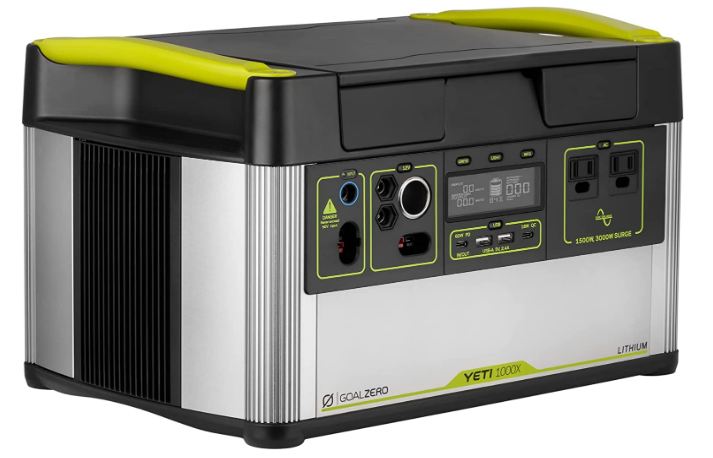Shopping for a portable solar generator that can power appliances?
I recommend the Goal Zero Yeti 1000X, a solar power station that strikes a great balance between power and portability.
The Yeti 1000X weighs 31.6lbs, light enough for truck camping, overlanding and RVs. Despite its compact size and relatively lightweight design, it can run most household appliances up to 1500W.
With its almost 1kW capacity, it’s also a great home backup solution for smaller appliances and devices.
Read on for my in-depth review of the Goal Zero Yeti 1000X.
If you are looking for a much lighter solar generator, see my reviews of the best portable solar generators. If you prefer a bigger unit that can keep your appliances running for longer during an emergency, read my reviews of the best backup solar generators.
Goal Zero Yeti 1000X Pros & Cons
Pros
Cons
Best Features
983Wh Li-ion Battery
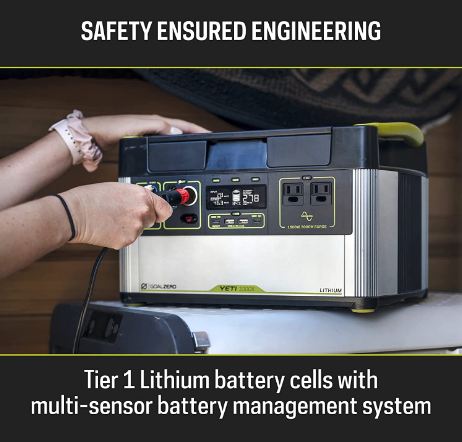
The roughly 1kWh capacity of the Yeti 1000X makes it a great choice for those who want a power station light enough for outdoor adventures yet large enough to power appliances at home, in a boat or in an RV.
983Wh can power smaller appliances for a few hours and larger appliances for an hour or two. It’s also enough capacity to keep your devices charged for days.
If you need more capacity, the Yeti 1000X is expandable. Use the expansion port to link it to Yeti Tank expansion batteries.
What Can The Goal Zero Yeti 1000X Power?
To give you an idea of what you can power with the Yeti 1000X, here are some approximate run times for various appliances and devices.
To calculate run time for any appliance, use the following formula: (983Wh * 0.85) / Appliance wattage
Appliance/Device | Approximate Runtime/Recharges |
|---|---|
42” LED TV (100W) | 8.3hrs |
CPAP (60W) | 14hrs |
Mini fridge (40W) | 20.8hrs |
Laptop (60Wh) | 14 recharges |
Smartphone (12Wh) | 69 recharges |
Bulb (11W) | 76hrs |
Microwave (1000W) | 48mins |
1500W Output
The Goal Zero Yeti 1000X has a surprisingly high output for its size. Most 1kWh solar generators produce about 1000W of power.
The Yeti 1000X produces up to 1500W of AC power, meaning it can power most household appliances in the US. Surge rating is 3500W, so the Yeti 1000X can handle things like power tools that require high startup power.
While the Yeti 1000X can run most appliances in your home, I don't recommend plugging high-consumption appliances like a heater or portable AC into it continuously.
They’ll drain the battery in no time.
If you want to power large appliances, consider getting the Yeti 3000X or 6000X.
11 Outlets
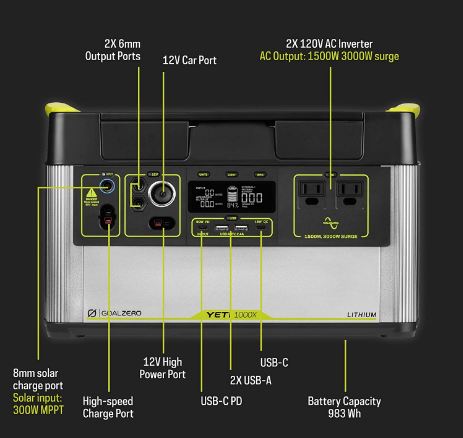
The Yeti 1000X has outlets that accommodate all sorts of devices and electronics.
For regular appliances, you get a couple of 120V AC outlets with a total output of 1500W.
For your 12V electronics and camping appliances like a CPAP or mini fridge, there are five 12V DC outlets, more than most solar generators. The high number of 12V ports is one of the reasons I highly recommend the Yeti 1000X for campers and outdoor enthusiasts.
There’s the main 12V car port with a max output of 160W. For bigger 12V appliances, there are also two high-power 12V ports with a max output of 180W.
And for smaller electronics like routers, there are two 12V 6mm ports with a max output of 120W.
Finally, the Yeti 1000X comes with four USB ports. These include two 5V, 12W USB-A ports, one 18W USB-C port, and one 60W USB-C PD port.
Three Ways To Recharge
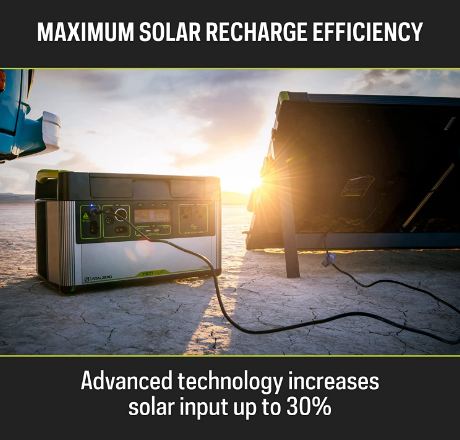
There are three ways to recharge the Yeti 1000X.
When you are at home or have access to grid power, you can charge the Yeti 1000X from a wall outlet. The included 120W charger takes 9 hours to recharge the battery.
Tip: You can also plug the Yeti 1000X into the outlet of a gas generator as long as it can provide at least 120W of power continuously.
During a power emergency or when you are outdoors, your best option is solar.
The Yeti 1000X has two solar charging ports. There’s an 8mm input port that accepts up to 150W of solar power (14-50V).
The main solar charging port is a 600W high power input port that lets you connect a bigger solar array (14-50V).
A 600W solar panel setup will recharge the Yeti 1000X in 2-4 hours, much faster than a wall outlet. You can also use a bigger solar array like 800W or 1200W.
As long as you don’t exceed 50V input, it won’t damage the power station. What it does is increase the chances that you are getting the max 600W of solar power most of the time. This reduces charging time.
The final way to charge the Yeti 1000X is from your vehicle’s 12V/24V port. But this method is slow, so I only recommend using it to top up the solar generator when you are on the move.
Decent Portability
The Goal Zero Yeti 1000X weighs 31.6lbs. Clearly, it’s not an ultra-light power station. If you want a solar generator mostly for camping and outdoors, I’d go with something lighter.
But it’s not too heavy either. If you are an occasional car camper who also wants a home backup power station, the Yeti 1000X is great.
By the way, Goal Zero sells a roll cart if you want an easier time moving the Yeti 1000X around.
Issues & Limitations
Charges Slowly
One of the biggest issues I’ve always had with Goal Zero solar generators is their slow charging speeds.
Most modern power stations charge fast, especially from a wall outlet. Bluetti and EcoFlow have larger capacity solar generators that charge quicker than the 9hrs the Yeti 1000X takes.
Luckily, you are not out of options. Goal Zero sells a more capable AC charger. There’s a 230W charger that reduces charging time to 4.5 hours and a 600W charger that recharges the battery in just a couple of hours.
On the downside, you have to pay extra to enjoy fast charging.
Battery Doesn’t Last As Long as LiFePO4
The other main issue with the Yeti 1000X (and all other Yeti solar generators) is that they use Li-ion batteries.
These are great for portability. Because of their high energy density, Li-ion batteries are lighter.
On the downside, they don't last as long as lithium phosphate (LiFePO4) batteries. The Yeti 1000X has a cycle life of 500 cycles to 80% capacity (or about 2-3 years of use). Total lifespan is 3-5 years on average.
In contrast, a LiFePO4 power station can last up to 10 years.
If you plan to use the Yeti 1000X power station frequently (e.g. daily or several times a week), I recommend getting a LiFePO4 power station instead. In the long term, it’s better value for money.
Best Goal Zero Yeti 1000X Alternatives
Goal Zero Yeti 1500X - More Capacity and Power
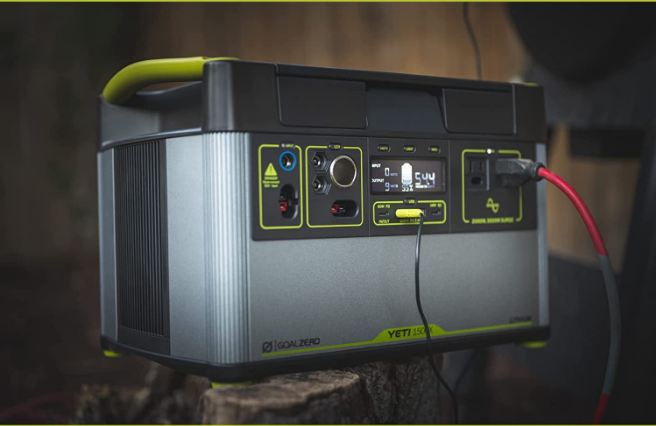
If you’d like to stick with the Goal Zero brand but want something more capable than the Yeti 1000X, I recommend its bigger sibling, the Yeti 1500X.
The Goal Zero Yeti 1500X has a capacity of 1,516Wh and a power output of 2000W. You can power larger appliances for longer.
The higher capacity and output make the 1500X heavier (43lbs), so I wouldn’t recommend it for most campers. But it’s great for RVs, camper vans, overlanding, truck campers and home backup.
The Yeti 1500X has the same slow charging issue as the Yeti 1000X. It takes 14 hours to recharge from a wall outlet. I highly recommend ordering the 600W charger (3hr charge time) when buying the 1500X solar generator.
Jackery Explorer 1000 - Lighter & More Portable
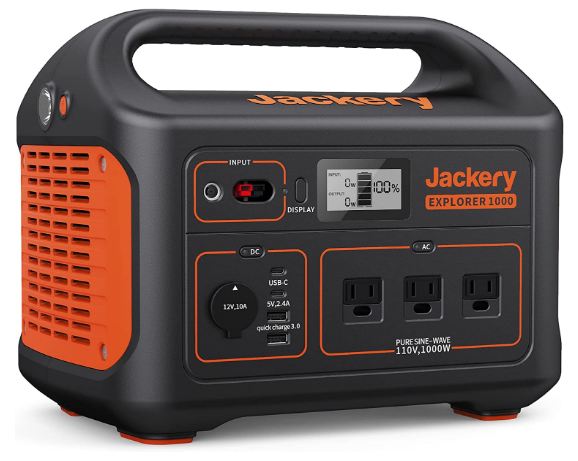
If you like the Yeti 1000X but find it a bit too heavy for your liking, the Jackery Explorer 1000 is roughly the same size but it’s almost 10 pounds lighter.
The Explorer 1000 weighs 22lbs and has a capacity of 1002Wh, so it’s actually slightly bigger than the Yeti 1000X.
Where the two power stations differ most is in power output. The Yeti 1000X can run 1500W appliances while the Explorer 1000 is limited to 1000W, so it’s more suited to powering smaller appliances.
I think the Explorer 1000 is the better choice for camping and outdoor adventures. It’s more portable and has enough power and capacity to run most of the appliances people travel and camp with like a mini fridge, CPAP and TV.
On the downside, the Explorer 1000 has just one 12V output.
EcoFlow Delta 2 - Longer Lasting LiFePO4 Battery
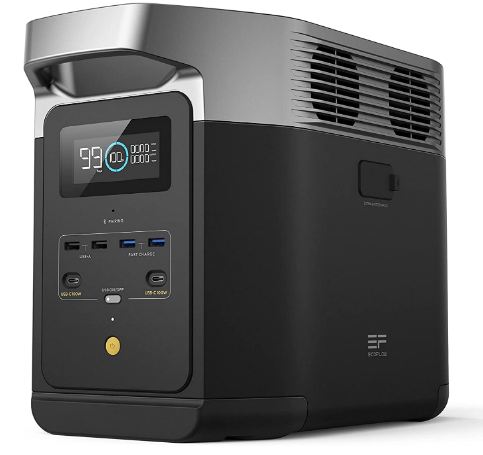
If you want a power station you can use often and it’ll still last for years, I recommend the EcoFlow Delta 2.
The Delta 2 solar generator uses a LiFePO4 battery that lasts over 3000 cycles to 80% capacity. It has a total lifespan of 5-10 years.
It has a capacity of 1024Wh and an output of 1800W. So it beats the Yeti 1000X in both areas.
Similar to the Yeti 1000X, you can expand the Delta 2 up to a capacity of 3kWh. The Delta 2 also charges way faster, taking just 50 minutes to recharge to 80%.
Overall, the EcoFlow Delta 2 has better value for money. It has a longer lifespan, more capacity, higher power output and faster charging and yet it costs less than the Yeti 1000X.
It’s even lighter (27lbs), despite using a heavier LiFePO4 battery.
Care and Maintenance
Solar generators don't need much maintenance. As long as you don't expose the Yeti 1000X to extreme temperatures or the elements, it’ll serve you well for years.
Check the manual for the recommended temperature range during charging, discharging and storage.
Another thing to note is that lithium batteries don't like being deeply discharged. If you don't plan to use the Yeti 1000X for a long time, either keep it plugged in (or connected to solar panels) or recharge it every 3 months.
Warranty
Goal Zero offers a 2-year warranty on the Yeti 1000X solar generator.
Specifications | |
|---|---|
Weight: | 31lbs |
Size: | 15.25 x 10.23 x 9.86 in |
Capacity: | 983Wh |
Ac Output: | 1500W continuous, 3500W surge pure sine wave inverter |
Outlets: | 2xAC, 2xUSB-A, 2xUSB-C, 5x12V DC |
Max solar input: | 600W |
Charging time: | 9 hours with AC adapter, 2-4 hours with 600W solar |
Battery chemistry: | Lithium-ion NMC |
Battery lifespan: | 500 cycles to 80% |
Operating temperature: | 32-104 F |
Where To Buy
The Goal Zero Yeti 1000X is available on the official Goal Zero website. You can also order it from Amazon.

